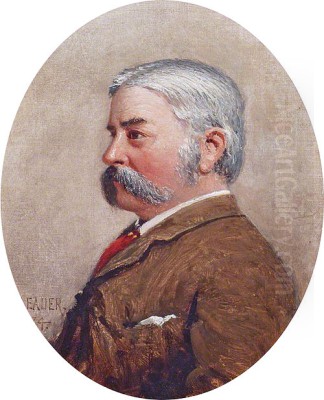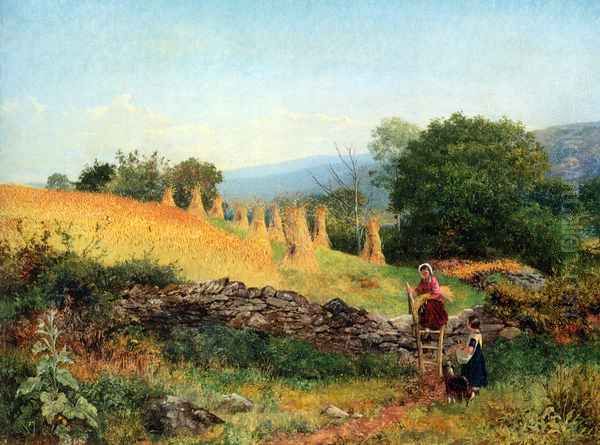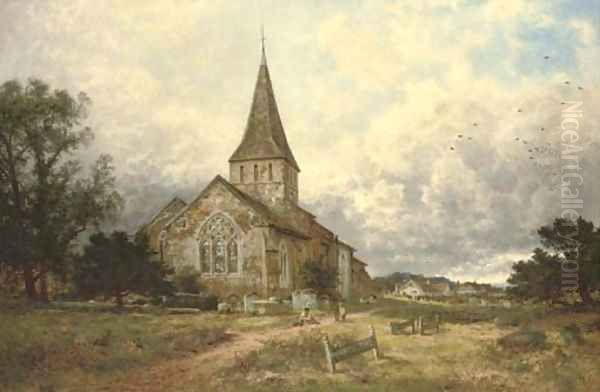
Benjamin Williams Leader stands as one of the most popular and successful landscape painters of the Victorian era in Britain. His long and prolific career spanned a period of significant change in the art world, yet he remained steadfast in his dedication to capturing the serene beauty and atmospheric nuances of the British countryside, particularly the landscapes of Worcestershire, Surrey, and Wales. His work, characterized by its accessible charm, technical skill, and evocative portrayal of light and weather, resonated deeply with the public and secured him a prominent place within the Royal Academy and the wider art market. Born Benjamin Leader Williams in Worcester on March 12, 1831, he passed away in Surrey on March 22, 1923, leaving behind a vast legacy of paintings that continue to be admired for their quintessential depiction of rural England and Wales.
Early Life and Artistic Formation
Benjamin's artistic inclinations were nurtured from a young age. His father, Edward Leader Williams, was a notable civil engineer but also a keen amateur artist. Significantly, the elder Williams was acquainted with the great English landscape painter John Constable, a connection that likely provided early inspiration for young Benjamin. The family home in Worcester, situated near the River Severn, offered ample opportunity for observation and sketching. Edward Leader Williams often took his son on sketching expeditions along the riverbanks, instilling in him a love for nature and the practice of drawing directly from the landscape.
This early, informal training was soon supplemented by formal education. Benjamin attended the Royal Grammar School in Worcester. His artistic talents led him to evening classes at the Worcester School of Design. For a time, he also worked in his father's engineering office as a draughtsman, an experience that may have honed his precision and attention to detail, qualities evident even in his later, broader works. However, his passion lay firmly in painting.

Recognizing his son's potential and ambition, Edward Leader Williams supported his decision to pursue art professionally. In 1853, at the age of 22, Benjamin was admitted to the prestigious Royal Academy Schools in London. This marked a crucial step, placing him at the heart of the British art establishment and providing rigorous training in drawing and painting. Though sources suggest he may not have completed the full course of study, his time at the RA Schools was formative.
The Royal Academy Debut and a Change of Name
Leader made his debut at the Royal Academy's annual exhibition in 1854 with a painting titled Cottage Children Blowing Bubbles. This work was reportedly purchased by an American buyer for the respectable sum of £50, an encouraging start for the young artist. He continued to exhibit regularly, quickly gaining recognition for his skillful depictions of nature.
A practical challenge soon arose. The surname "Williams" was remarkably common among artists in London at the time, including the talented members of the Williams family of painters, such as Edward Williams. To avoid confusion and establish a distinct artistic identity, Benjamin took a decisive step in 1857. He reversed the order of his middle and last names, adopting the professional name Benjamin Williams Leader. This simple change proved effective, allowing his work to be easily identified throughout his long career.
Early Influences: The Pre-Raphaelite Touch
In the mid-19th century, the London art scene was significantly impacted by the Pre-Raphaelite Brotherhood (PRB), founded in 1848 by artists like John Everett Millais, William Holman Hunt, and Dante Gabriel Rossetti. The PRB advocated a return to the intense colour, intricate detail, and complex compositions of Quattrocento Italian art, rejecting what they saw as the formulaic and overly idealized approach of later academic painting, particularly that influenced by Sir Joshua Reynolds. A key tenet of their philosophy was "truth to nature," which involved meticulous observation and detailed rendering of the natural world.
While Leader never formally joined the Brotherhood, his early works clearly show the influence of Pre-Raphaelite principles. Paintings from the late 1850s and early 1860s often feature a high degree of detail, crisp outlines, and a bright, clear palette. He embraced the practice of painting outdoors (en plein air) to capture natural effects accurately, a method strongly advocated by the influential critic John Ruskin, who championed both the PRB and J.M.W. Turner. This detailed approach can be seen in works focusing on specific botanical elements, geological formations, and the textures of the landscape.

This early phase demonstrated Leader's technical proficiency and his commitment to careful observation. It aligned him with progressive trends in British art that emphasized fidelity to the natural world over academic convention. However, his adherence to strict Pre-Raphaelite detail would gradually soften as he developed his own distinct artistic voice.
Developing a Personal Style: Towards Naturalism and Atmosphere
As Leader matured as an artist, his style evolved. While retaining a fundamental commitment to representing the landscape accurately, he moved away from the microscopic detail associated with the stricter Pre-Raphaelites like William Holman Hunt or early John Everett Millais. Instead, he began to focus more on capturing the overall mood, atmosphere, and transient effects of light and weather. His brushwork became somewhat broader, though always controlled, allowing for a more unified and evocative depiction of the scene.
His primary inspiration remained the British landscape itself. He developed a particular fondness for certain regions, returning to them repeatedly throughout his career. The gentle hills, winding rivers, and rustic cottages of his native Worcestershire were frequent subjects. He was also captivated by the dramatic mountains, valleys, and streams of North Wales, particularly around Betws-y-Coed and Capel Curig. Later in life, after moving to Surrey, the sandy heaths, pine woods, and quiet lanes of that county became prominent features in his work.
A defining characteristic of Leader's mature style was his mastery of light, especially the warm, golden light of late afternoon and sunset. This "amber luminosity," as it has been described, suffuses many of his most popular paintings, creating a sense of peace, nostalgia, and gentle melancholy. He excelled at depicting reflections in water, the dampness of a rainy day, the crispness of frost, and the lingering glow after sunset. This focus on atmospheric effects, while different from the scientific colour theory of French Impressionism (artists like Claude Monet or Camille Pissarro), showed a related interest in capturing the fleeting moments of nature.
Masterpieces and Signature Works
Throughout his long career, Leader produced a number of paintings that became exceptionally popular and are now considered his signature works. Among the most celebrated is February Fill Dyke, exhibited at the Royal Academy in 1881. The title refers to an old country saying describing the typically wet weather of late winter that fills the drainage ditches. The painting depicts a sodden, wintry landscape at sunset. A low, watery sun breaks through the clouds, casting a pale yellow light across the flooded fields and reflecting in the puddles along a muddy track. Bare trees stand starkly against the luminous sky, and a lone figure with a dog walks along the path.
February Fill Dyke was an immediate success. It perfectly captured a specific mood and time of year familiar to many in Britain. Its combination of realism, atmospheric effect, and gentle sentiment resonated strongly with Victorian audiences. The painting was purchased for the Chantrey Bequest, a fund established to buy works of art for the nation, and is now housed in the Birmingham Museum & Art Gallery. It remains one of the most iconic images of Victorian landscape painting.
Another highly renowned work is The Valley of the Llugwy, painted several times with variations but perhaps most famously represented by the version exhibited in 1883. This painting depicts a scene in North Wales, near Betws-y-Coed, an area beloved by many Victorian artists. It shows the River Llugwy flowing through a tranquil valley, with lush green fields, scattered trees, and distant mountains under a soft, luminous sky. The composition is carefully balanced, leading the viewer's eye into the serene landscape. Like February Fill Dyke, it captures a specific sense of place and atmosphere, appealing to the Victorian appreciation for the beauty of the British landscape. This work, or a version of it, found its way into the collection of the National Gallery in London.
Other notable works showcase the range of his subjects and his consistent style. Autumn's Last Gleam captures the rich colours and fading light of the season. Stepping Stones across the Conway, North Wales focuses on a picturesque river scene. An Old Worcester Farm reflects his deep connection to his native county. Even works depicting coastal scenes or incorporating figures, like Ramsgate Sands or Beach Life, demonstrate his skill in composition and observation, though landscape remained his primary focus. These paintings, often reproduced as prints, cemented Leader's reputation as a painter whose work was both artistically accomplished and widely accessible.
The Royal Academy and Professional Success
The Royal Academy of Arts was the dominant institution in the Victorian art world. Election to its ranks and regular exhibition at its prestigious Summer Exhibition were crucial markers of success for an artist. Benjamin Williams Leader achieved significant recognition within this establishment. He exhibited works at the RA almost every year from his debut in 1854 until 1922, the year before his death – a remarkable record spanning nearly seven decades.
His growing reputation and the consistent quality of his work led to formal honours. In 1883, he was elected an Associate of the Royal Academy (ARA). This was followed fifteen years later, in 1898, by his election as a full Royal Academician (RA), the highest rank within the Academy. These accolades placed him among the elite of the British art world, alongside contemporaries such as the President of the RA, Frederic Leighton, and fellow popular landscape painters like George Vicat Cole.
Leader's success was not confined to critical acclaim; he also achieved considerable commercial prosperity. His paintings were highly sought after by middle-class collectors who appreciated their recognisable subjects, skillful execution, and pleasant sentiment. Major art dealers, such as Thomas Agnew & Sons and Thomas Wallis, recognised the appeal of his work and played a significant role in promoting and selling his paintings. This ensured a steady income and allowed him to maintain a comfortable lifestyle, eventually settling in a large house, "Burrows Cross," in Shere, Surrey.
His patrons included prominent figures. William Gladstone, the four-time Prime Minister, was an admirer and purchased his work. Later, King George V also acquired paintings by Leader, signifying royal approval and further enhancing his status. This combination of academic recognition, popular appeal, and commercial success made Leader one of the most established and respected artists of his generation.
International Recognition
Leader's reputation extended beyond the shores of Britain. His work was exhibited internationally, contributing to a wider appreciation of British landscape painting. A significant moment of international acclaim came at the Paris Exposition Universelle (World's Fair) in 1889. At this major event, Leader was awarded a Gold Medal for his paintings, a prestigious honour that recognised his standing on the European stage.
In the same year, his achievements were further acknowledged by the French government, which made him a Chevalier of the Legion of Honour. This French decoration was a significant mark of distinction, rarely awarded to foreign artists, and underscored the international appeal of his quintessentially British landscapes. While French art was undergoing radical transformations with Impressionism and Post-Impressionism (led by figures like Georges Seurat and Paul Cézanne), Leader's more traditional, naturalistic style clearly found favour with international juries and audiences who appreciated its technical skill and evocative power.
His success in Paris demonstrated that his vision of landscape, while deeply rooted in the British tradition tracing back through Constable, had a universal appeal. It spoke to a widespread appreciation for carefully rendered natural beauty and atmospheric sensitivity, even as artistic avant-gardes were exploring different paths.
Later Years and Evolving Techniques
Benjamin Williams Leader remained remarkably productive into his old age. He continued to paint and exhibit well into his eighties and even early nineties, adapting his life and work routines as necessary. He maintained his home and studio, "Burrows Cross," in the Surrey Hills, a landscape that provided endless inspiration for his later works. The pine woods, sandy tracks, and village scenes of Surrey feature prominently in paintings from this period.
While his fundamental style remained consistent – rooted in naturalistic observation and a focus on light and atmosphere – some subtle shifts can be observed in his later work. There is perhaps a tendency towards broader handling in some passages, a slightly looser application of paint, hinting at an absorption of some aspects of Impressionistic technique, though he never fully embraced the broken colour or dissolved forms of French Impressionism. His primary goal remained the depiction of a recognisable and emotionally resonant landscape.
His later years were marked by personal loss, particularly the death of his younger brother, the painter Eastlake Benjamin Leader, who was killed in action during the First World War. Despite such sorrows, and the dramatic changes occurring in the art world with the rise of Modernism (movements like Cubism and Fauvism were already established), Leader continued to paint the landscapes he loved. He remained a popular figure, representing a continuity with the Victorian era that many still cherished. His death in March 1923, shortly after his 92nd birthday, marked the end of a remarkably long and successful artistic career.
Contemporaries and Context
To fully appreciate Benjamin Williams Leader's achievement, it's helpful to place him within the context of his contemporaries. He emerged during the ascendancy of the Pre-Raphaelites (Millais, Hunt, Rossetti) and was initially influenced by their detailed naturalism, as were other landscape specialists like John Brett, known for his incredibly detailed coastal scenes.
As Leader developed his more atmospheric style, he joined the ranks of highly popular Victorian landscape painters who catered to a large public appetite for scenes of rural Britain. Artists like Myles Birket Foster, primarily a watercolourist but immensely popular for his idyllic country scenes, shared a similar market. Within the Royal Academy, landscape painters like George Vicat Cole and Alfred William Parsons achieved comparable success and status, often depicting similar subjects in a broadly naturalistic style. Leader's particular skill lay in his consistent ability to capture specific effects of light and weather, particularly the evening glow that became his hallmark.
Compared to the towering figure of J.M.W. Turner, whose late works dissolved form into pure light and colour, Leader's approach was far more conservative, remaining grounded in representation. He also differed significantly from the French Barbizon School painters (like Jean-Baptiste-Camille Corot or Théodore Rousseau) who sought a more direct, unidealized portrayal of peasant life and landscape, and even more so from the French Impressionists (Monet, Pissarro, Alfred Sisley) with their revolutionary approach to colour and light. Leader represented the mainstream of successful British landscape painting in the latter half of the 19th century – technically proficient, emotionally appealing, and deeply connected to the national landscape.
Legacy and Historical Assessment
During his lifetime, Benjamin Williams Leader was immensely popular. His paintings were widely exhibited, eagerly collected, and frequently reproduced as prints, making his images familiar to a broad public. He achieved the highest honours available to a British artist through the Royal Academy and gained significant international recognition. For many Victorians and Edwardians, his work represented the pinnacle of landscape painting, perfectly capturing the beauty and sentiment of the British countryside.
However, critical assessment has fluctuated. During the rise of Modernism in the early 20th century, Leader's traditional style, along with that of many other successful Victorian academicians, fell out of critical favour. His work could be seen as repetitive, overly sentimental, or lacking the innovative drive of the avant-garde. The very qualities that made him popular – accessibility, recognisable subjects, pleasant moods – were sometimes viewed negatively by critics championing more challenging art. Some critics noted a tendency towards formula in his later works.
Yet, his reputation has endured, particularly among collectors and the public. In recent decades, there has been a renewed appreciation for Victorian art, and Leader's work has been reassessed. His technical skill is undeniable, particularly his handling of light and atmosphere. His paintings are recognised as masterful evocations of specific places and moods, capturing a vision of rural Britain that, while perhaps idealized, holds lasting appeal. His works continue to command high prices at auction, confirming his status as a major figure in 19th-century British art.
His legacy lies in his creation of a definitive visual record of the Victorian perception of the British landscape. He provided images of tranquility and natural beauty that resonated deeply with his contemporaries and continue to evoke a sense of place and time. While not an innovator on the scale of Constable or Turner, or the French Impressionists, Leader perfected a particular kind of landscape painting that achieved enormous success and left an indelible mark on British art history.
Conclusion
Benjamin Williams Leader navigated the complex art world of the Victorian and Edwardian eras with remarkable success. From his early training and Pre-Raphaelite influences to the development of his signature atmospheric style, he remained dedicated to capturing the landscapes of Britain. His mastery of light, particularly the evocative glow of evening, combined with his skillful compositions and appealing subjects, earned him widespread popularity, academic honours, and international awards. Works like February Fill Dyke and The Valley of the Llugwy became iconic images of the era. Though critical fortunes may ebb and flow, Leader's enduring appeal and his significant contribution to the tradition of British landscape painting remain secure. He stands as a quintessential Victorian artist, whose canvases continue to offer viewers a glimpse into the serene and subtly beautiful world he so expertly portrayed.